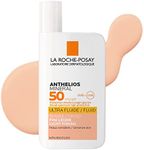Buying Guide for the Best Mineral Sunscreens
Choosing the right mineral sunscreen is important for protecting your skin from harmful UV rays while also considering your skin type, lifestyle, and preferences. Mineral sunscreens use physical blockers like zinc oxide or titanium dioxide to reflect UV rays, making them a popular choice for sensitive skin and those looking for broad-spectrum protection. When shopping for a mineral sunscreen, it's helpful to understand the key features and how they relate to your needs, so you can find a product that feels comfortable, works effectively, and fits your daily routine.Active IngredientsThe active ingredients in mineral sunscreens are usually zinc oxide, titanium dioxide, or a combination of both. These minerals sit on top of the skin and physically block UV rays. Zinc oxide offers broad-spectrum protection against both UVA and UVB rays, while titanium dioxide is especially effective against UVB rays. If you have sensitive skin or are looking for the most comprehensive protection, a sunscreen with a higher percentage of zinc oxide may be preferable. For lighter feel or less white cast, some people opt for formulas with more titanium dioxide. Consider your skin sensitivity and desired level of protection when choosing between these ingredients.
SPF RatingSPF, or Sun Protection Factor, measures how well a sunscreen protects against UVB rays, which cause sunburn. Common SPF values are 15, 30, 50, and higher. SPF 15 blocks about 93% of UVB rays, SPF 30 about 97%, and SPF 50 about 98%. For everyday use, SPF 30 is generally recommended, while higher SPFs are better for extended outdoor activities or very fair skin. Think about how much time you spend outside and your skin’s sensitivity to sunburn when picking the right SPF.
Broad-Spectrum ProtectionBroad-spectrum protection means the sunscreen shields your skin from both UVA and UVB rays. UVA rays can cause premature aging and skin damage, while UVB rays are responsible for sunburn. Not all sunscreens offer broad-spectrum coverage, so it’s important to check the label. If you want complete protection from sun damage, always choose a mineral sunscreen labeled as broad-spectrum.
Texture and FinishMineral sunscreens can vary in texture, from thick creams to lightweight lotions or gels. Some may leave a white cast on the skin, especially those with higher concentrations of zinc oxide. If you have darker skin or prefer a more natural look, look for formulas labeled as 'sheer,' 'tinted,' or 'invisible.' For daily wear under makeup, a lightweight or matte finish may be more comfortable. Consider your skin tone, how you want the sunscreen to look and feel, and whether you’ll be layering it with other products.
Water ResistanceWater resistance indicates how long the sunscreen remains effective while you’re sweating or swimming. Labels usually state 40 or 80 minutes of water resistance. If you plan to swim, exercise, or spend time outdoors in hot weather, a water-resistant formula is a good choice. For everyday indoor use, water resistance may be less important. Match the level of water resistance to your activities.
Skin Sensitivity and AdditivesSome mineral sunscreens include added ingredients like fragrances, essential oils, or preservatives, which can irritate sensitive skin. If you have allergies, eczema, or very sensitive skin, look for products labeled 'fragrance-free,' 'hypoallergenic,' or 'for sensitive skin.' Reading the ingredient list can help you avoid potential irritants and find a sunscreen that’s gentle enough for daily use.















